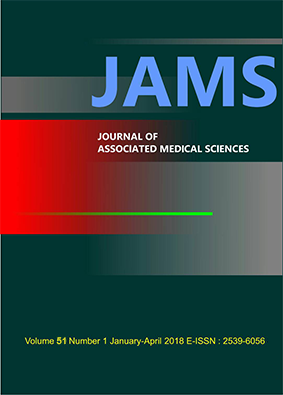The diagnostic X-ray exposure technique guidelines for elephants’ limbs in Elephant Hospital, Thai Elephant Conservation Center, Thailand
Main Article Content
Abstract
Background: Radiographic image is the first of choice for diagnosing complications involving elephants’ limbs. The extreme thickness of their limbs causes inaccurate image quality. Therefore, an appropriate procedure is hereby investigated as a matter concerned. Because of difference of X-ray absorption in elephant tissue from human tissue, the Sante’s rule cannot be directly applied.
Objectives: This study sought to acquire the appropriate equation by modifying the Sante’s rule with a tissue factor for calculating the exposure technique for Asian elephants’ limbs.
Materials and methods: Firstly, capacity of a mobile X-ray machine was evaluated in terms of dose rate, precision, and accuracy of radiation. The exposure techniques were then designed using the modified Sante’s rule and tested with the hind limbs of 10 live elephants.
Results: Output of X-ray machine revealed the dose rate in milli-Rontgen per milli-Ampere-sec equal to 4×10-4 of kVp2, and the machine factor equal to 6.4. The radiographic images taken using the calculated exposure techniques showed good quality, and so, it is possible to differentiate between the medullar and the cortex of the bone.
Conclusion: Equations suitable for designing the exposure technique are kVp equal to two times of sample thickness in centimeter plus source image distance in inche and the tissue correcting factor 5, and mAs equal to two-fifths of the sample thickness in centimeters.
Article Details
Personal views expressed by the contributors in their articles are not necessarily those of the Journal of Associated Medical Sciences, Faculty of Associated Medical Sciences, Chiang Mai University.
References
[2] Sukklad S, Sommanustweechai A, Pattanarangsan R, editors. A retrospective study of elephant wound, wound management from Thai veterinarians 2006 26-29 Oct 2006 Chulalongkorn Uni. Fac. of Vet. Sc., Bangkok, Thailand.
[3] Miller D, Jackson B, Riddle HS, Stremme C, Schmitt D, Miller T. Elephant (Elephas maximus) Health and Management in Asia: Variations in Veterinary Perspectives. Vet Med Int. 2015;2015:19.
[4] Freedman MT, Bush M, Novak GR, Heller RM, James AE. Nutritional and metabolic bone disease in a zoological population. Skeletal Radiol. 1976;1(2):87-96.
[5] Kaulfers C, Geburek F, Feige K, Knieriem A. Radiographic imaging and possible causes of a carpal varus deformity in an Asian elephant (Elephas maximus). J Zoo Wildl Med. 2010;41(4):697-702.
[6] Mumby C, Bouts T, Sambrook L, Danika S, Rees E, Parry A, et al. Validation of a new radiographic protocol for Asian elephant feet and description of their radiographic anatomy. Vet Rec. 2013;173(13):318.
[7] Siegal-Willott J, Isaza R, Johnson R, Blaik M. Distal limb radiography, ossification, and growth plate closure in the juvenile Asian elephant (Elephas maximus). J Zoo Wildl Med. 2008;39(3):320-34.
[8] Theerapan W. Radiographic study on bone maturation of distal limbs in Asian elephans: Chulalongkorn University. Bangkok. (Thailand). Graduate School.; 2003.
[9] Tongtip N, Thengchaisri N, Viriyarumpa J, editors. Estimation of radiographic exposure in Asian elephant limbs. 37th Kasetsart University Annual Conference; 1999; Bangkok (Thailand): Kasetsart University, Bangkok (Thailand).
[10] van der Kolk JH, van Leeuwen JP, van den Belt AJ, van Schaik RH, Schaftenaar W. Subclinical hypocalcaemia in captive Asian elephants (Elephas maximus). Vet Rec. 2008;162(15):475-9.
[11] Holtgrew-Bohling K. Large Animal Clinical Procedures for Veterinary Technicians, 3e. 3 edition ed. St. Louis, MO: Mosby; 2015 October 13, 2015. 704 p.
[12] IAEA. Diagnostic Radiology Physics2014 2014. 681 p.
[13] David RL. CRC Handbook of Chemistry and Physics, 89th Edition - CRC Press Book. 89th ed: CRC Press; 2008 2008-2009. 2736 p.
[14] IAEA. Dual Energy X Ray Absorptiometry for Bone Mineral Density and Body Composition Assessment. 2011.
[15] Schneider CA, Rasband WS, Eliceiri KW. NIH Image to ImageJ: 25 years of image analysis. Nat Meth. 2012;9(7):671-5.
[16] Ayad M, Bakazi A, Elharby H, editors. Dosimetry measurements of X-Ray machine operating at ordinary radiology and fluoroscopic examinations. The Third Nuclear and Particle Physics Conference (NUPPAC-2001); 2002; Egypt.
[17] Lavin LM. Radiography in veterinary technology. 2nd ed. ed. Philadelphia, Pa.:: W.B. Saunders; 1999 1999.
[18] Dudley RJ, Wood SP, Hutchinson JR, Weller R. Radiographic protocol and normal anatomy of the hind feet in the white rhinoceros (Ceratotherium simum). Vet Radiol Ultrasound. 2015;56(2):124-32.


